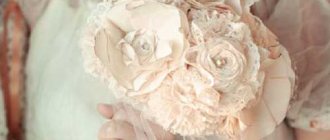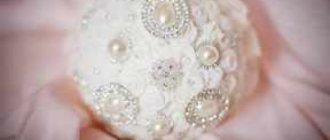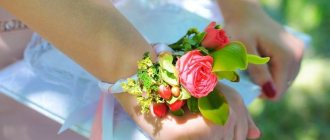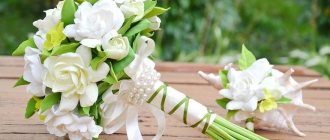Just like the bride's bouquet
complements the image of the newlywed, the groom's boutonniere is a mandatory accessory of a wedding suit. Men began wearing boutonnieres more than five hundred years ago, and during this time several fashion trends have changed, new materials and styles have appeared. However, a boutonniere made of fresh flowers has never lost its relevance and is still popular. In this article we will tell you what to look for when choosing its design and how to make it yourself.
What is a boutonniere
A boutonniere is a miniature arrangement made up of fresh or artificial flowers. This word translated from French means “flower in the buttonhole.” At European wedding events, the groom's suit was decorated with a small flower, which was inserted into the buttonhole of the jacket lapel. Now not only men, but also girls can wear boutonnieres, decorating their wrists or hairstyles with them.
Since the wedding should be decorated in the same style and color scheme, there are some requirements for accessories:
- Wedding compositions must match the overall color scheme of the event. The shades of the flowers should be in harmony with each other and the bride’s bouquet.
- If the wedding is themed and the bride's bouquet is made in a certain style (for example, wildflowers), boutonnieres should support these trends.
- The decoration should be in harmony with the groom's suit.
- The accessory usually consists of 1-3 flowers, which can be complemented with various decor. A larger number of plants will overload the composition.
Summary
With the right amount of imagination and patience, anyone can make an original boutonniere that will emphasize the solemnity of the event. For stylized weddings, you can use not only flowers in the composition, but also any available materials, such as a boutonniere for the groom made of foamiran.
admin 115
Previous article
What kind of tights do you wear under a wedding dress?
Next article
Where did the tradition come from?
The word “boutonniere” came into Russian from French; literally translated, it means “flower in the buttonhole.” The attribute itself has been known since pagan times. Men attached a small bud to their wedding vestments before the ceremony, it was believed that this would scare away evil spirits.
Different cultures believed that if this was not done, evil spirits could lead the groom astray from his chosen path, and the wedding would not take place. According to other beliefs, the absence of a boutonniere could provoke misfortune with the bride, so men strictly adhered to this tradition.
In the Middle Ages, the attribute began to be used by knights - by pinning a flower to their clothes on the side of the heart, they said that they were in love and faithful to their lady. At that time, only noble people wore boutonnieres; the miniature bouquet was made by servants. To keep it fresh longer, it was placed in a small flask with water and attached to clothing.
According to the established tradition, after the bride price, the groom gives his beloved a bouquet, and she, in turn, attaches a boutonniere to his suit. You can place it in the main flower arrangement in advance. Then, after the groom gives the bride a bouquet, she will take a flower from it and attach it to her future husband on the side of her heart as a sign of eternal love, as happened in Rome.
In the modern wedding tradition, a boutonniere is more of a tribute to tradition; no sacred meaning is attached to it. This attribute can be ordered from a florist or made by yourself. For this you can use both natural and artificial plants. Usually the bride is responsible for making a mini-bouquet, so the girl can use her imagination and create a unique composition.
Important! The groom should fasten the boutonniere on the left side of the pocket or lapel of his jacket. If the attribute is also made for guests, single men attach it to the left, married men to the right.
How to attach a boutonniere to a jacket
In order for the wedding celebration to go perfectly, it is important not to forget to take into account every little detail. Such significant details include the boutonniere, which is attached to the groom's suit.
It would seem that it could be simpler, but even in such a simple matter, mistakes can be made.
We attach the boutonniere to the groom's jacket
If you want to have a wedding according to all the canons, then it is worth including such a touching tradition as attaching a boutonniere. This is done by the bride after the groom gives her a wedding bouquet. Initially, she took out a couple of flowers from it, immediately made a boutonniere out of them and inserted it into her buttonhole. But since this takes a lot of time, and not all brides can do it as beautifully as floral designers, this element of tradition is omitted in most cases.
This action is not always carried out at the wedding itself. Many newlyweds do not see the point in this tradition, so the boutonniere is attached in advance, while preparing the costume.
She can look whatever she wants. The classic version was described above - these are flowers from the bride’s bouquet. But it could be another bouquet that has something in common with it in color (although this is not necessary). Additional decorations are also used: feathers, spikelets, grass and leaves. There are also completely non-standard options, for example, with small figures, bells, cones or pearls.
Where to attach
Traditionally, this is the left lapel of the jacket, closer to the heart. But modern newlyweds like to deviate from standard wedding looks, so more and more often you can see grooms wearing a shirt, or at most, a vest over it. In both cases, the boutonniere is attached to the breast pocket.
IMPORTANT! This will be discussed below, but it should be attached to the pocket, and not inserted into it. Many of those who organize a wedding in the same style like to add additional unifying elements to the guests’ costumes.
One option could be identical bouquets that decorate witnesses and/or parents of the bride and groom
Many of those who organize a wedding in the same style like to add additional unifying elements to the guests’ costumes. One option could be identical bouquets that decorate the witnesses and/or parents of the bride and groom.
For men, the requirements remain the same (except that their boutonniere should not be more striking than that of the groom). Women attach a bouquet near the neckline of a dress or on a belt. Bracelets with boutonnieres are also common.
How to attach
A ready-made purchased (or ordered) bouquet is most often initially attached to a clip or safety pin. But there are exceptions, in which case two corsage pins will help you. To attach the boutonniere:
- pierce the lapel of the jacket from the inside;
- pass the pin through the stem, closer to the flower;
- bring it back into the fabric;
- attach the second pin in the same way, passing it through the bottom of the stem.
The same sequence of actions is suitable for hand-made boutonnieres.
BY THE WAY! If you do not want to follow tradition and prepare this element of the costume in advance, then for reliability you can sew it with threads, and then you can certainly be sure that it will not fall off at the most inopportune moment.
Basic mistakes
There are two of them. The first is that many people do not care about securing the boutonniere and simply “put” it in their breast pocket. This is very unreliable, since the bouquet can fall out from any movement, even if the groom simply raises one hand up, not to mention dancing and active competitions.
Secondly, many people consider flowers to be the most important element of a boutonniere, so the stems are either cut off or hidden. As a result, the resulting decoration looks incomplete and unfinished. The leg adds elegance and naturalness to it.
To follow or not to follow traditions is up to you to decide. But in any case, the boutonniere will become an exquisite detail of the groom’s image, which means it is in your best interests to make sure that it is held as securely as possible.
How to choose flowers
If you decide to create a boutonniere from living plants, keep in mind that they may not be durable and will fade very quickly. Before starting production, consult a florist about which plants retain their freshness and appearance for a long time. This is an important moment at a wedding, as wilted flowers in the decor look ugly and spoil the entire festive image.
Flowers that have a beautiful appearance and are long-lasting include: carnations, freesias, alstroemerias, chrysanthemums, etc. A common option are classic roses, which look good in any composition, and similar ranunculus. Plants of an unusual type include succulents, which are distinguished by their unpretentiousness and increased durability. They are commonly used in rustic weddings and also to decorate winter events.
To create boutonnieres, you need to use small buds so that they look harmonious on the lapel of the jacket and do not take up too much space. If the accessory consists of one flower, it can be medium in size. Dried flowers, green twigs and leaves are suitable for decorating the composition.
When choosing plants, keep in mind that their aroma should not be too strong, otherwise people with a sensitive sense of smell may experience discomfort. It is also better that the buds do not have pollen. If it falls off, it can ruin the groom's wedding attire.
Creative modern ideas
Designers love to break the traditional idea of what a boutonniere is. They create this wedding accessory from the most unusual materials, combinations of colors and shapes. Among the original ideas for boutonniere design are:
- Marine version - twine, shells, stars, pearls, pieces of coral are used to make it.
- In the steampunk style - a composition of clock mechanisms, keys, feathers.
- In a rustic style - a bouquet consisting of several ears of corn, buttons, tiny sunflowers or dried cotton flowers.
- Autumn design - red berries, small cones, branches of evergreen bushes (arborvitae, juniper, boxwood, cherry laurel).
Types of accessories
As such, there is no division of boutonnieres into varieties; they can be roughly divided into living and artificial. A mini-wedding composition can also be classified according to style - if the celebration is thematic, then all the attributes must correspond to the general idea.
If earlier a separate large flower was used as a boutonniere, now there is another option - creating a real miniature bouquet from one main plant and several additional ones. A boutonniere for the groom made from fresh flowers can carry a deeper meaning, according to the language of flowers.
The following plants are commonly used:
- Rose. The most common flower for weddings. A white bud means innocence, a red boutonniere for the groom means passion, pink means the beginning of love, yellow means happiness and joy, and orange means intoxicating feelings.
- Peony. A boutonniere for the groom made of peonies, regardless of the shade, symbolizes love, beauty and protection. This is one of the noblest flowers in China; only noble people could grow it.
- Lily. A large bud symbolizes purity, wealth and prosperity in the family.
- Lilac. If the wedding takes place in the spring, lilac is one of the best options, since it is identified with the first and only love.
- Calla. Symbolizes love blessed by higher powers.
- Jasmine. In some countries, modesty and purity of love are attributed to this flower, in others it is believed that it symbolizes passion and ardor of feelings.
- Mistletoe. It has long been considered a symbol of lovers.
- Daisy. Symbolizes eternal pure love.
- Aster. Identified with grace, sincerity and love.
Depending on the style of the wedding, the boutonniere can be supplemented with other natural elements at your discretion. For example, cereal ears, bird feathers, wildflowers, twigs with berries, leaves or blades of grass of bizarre shapes are suitable.
A boutonniere made from artificial materials also has its advantages - it will not lose its original appearance during the celebration and will remain with the newlyweds for many years as a symbol of strong love. To make an attribute, satin ribbons, beads, pieces of fabric and other materials can be useful.
Attention! It is not necessary to follow the language of flowers; you can use any plants you like if they suit the image of the groom and the style of the wedding as a whole. However, if it is important to you what flowers symbolize, we examined this in more detail using the example of a wedding bouquet.
Basic rules for creating a boutonniere
If you decide to make this decoration yourself, then you should know what to pay attention to in the process of creating a boutonniere.
- The boutonniere should match the bride's bouquet and wedding style. So, you can use the same flowers that the bride will hold in her hands, but the boutonniere should look a little more modest so as not to distract attention from the bride.
- It is important to choose the correct size of jewelry. A boutonniere that is too large will look out of place, while a boutonniere that is too small will simply get lost and go unnoticed.
- The color scheme of the boutonniere should be correctly combined with the groom's suit.
- The fixing elements must be as reliable as possible so that the decoration does not fall off in the midst of the celebration.
- It is better to make a miniature bouquet of one or three flowers. These can be flowers of one or several types, then the boutonniere will not look too poor or, on the contrary, tacky.
Do it yourself
Let's consider the most sophisticated options.
Mini composition
How to make a boutonniere for the groom? The easiest option to create a mini-composition is to use one large bud and several branches with small inflorescences or berries. Many people prefer to choose a rose, lily or kala for this, which are suitable for almost any image, and the shade can be selected depending on the color of the groom’s suit.
To make a boutonniere, you will need the following materials:
- 1 large fresh flower (you can take several, with a reserve);
- sprigs of gypsophila or hypericum;
- green tape;
- floral wire;
- safety pin for fastening;
- scissors.
Before creating a boutonniere, you need to cut the stem of the plant at an acute angle and place it in water for at least 4 hours, this will allow the bud to stay fresh longer. It is advisable to decide in advance on the desired length; usually 1 cm of stem is enough to create a durable composition. It is recommended to dip a cut of a flower in liquid paraffin or wax so that there are no wet spots left on the groom’s suit.
Then you need to cut two pieces of wire approximately 7 cm long, pierce the stem crosswise with them as close to the bud as possible and bend them parallel to the stem. Additional plant branches also need to be strung on floral wire, bent on one side with a hook. Having collected all the elements together, you need to intertwine the wires together and wrap them tightly with tape. The finished boutonniere is secured with a safety pin.
Gypsophila and hypericum are more suitable for roses or peonies, and for lilies and callas it is better to choose greens without inflorescences, but with larger leaves.
In the form of a mini bouquet with lavender
If the wedding will be held in the style of Provence, rustic, vintage, or the newlyweds simply decided to hold the celebration in the fresh air, it is best to make a flower arrangement of wildflowers. In this case, lavender is often chosen as the base, which symbolizes admiration.
You can use lavender as a single composition, wrapping it in a kind of linen wrapper. In addition, you can add additional elements - spikelets of cereals, thin green blades of grass or small wildflowers in pastel shades. This boutonniere should not be weighed down with bright accents or large buds. You should not use wire; it is better to secure the mini-bouquet with twine or other suitable material.
Peony from individual petals
Peony is considered a noble flower, since in ancient times in the countries of the East only noble people grew this plant in their gardens. Today, peony is found in almost all countries, and its popularity does not fade. From satin ribbons you can make a high-quality imitation with your own hands, very similar to the original. To do this you will need:
- satin ribbon of a suitable shade 5-6 cm wide;
- thin threads to match the color of the ribbon;
- needle;
- scissors;
- glue gun;
- wire;
- yellow glitter or microbeads;
- pattern paper;
- candle and matches.
To make a peony from satin ribbons with your own hands, you must first make a pattern of the petals. To do this, on paper you need to draw a blank 5 cm high or a little less in the form of a wide heart with the tip cut off in a straight line, the base should be approximately 25 mm. Using this pattern, you need to cut 6 identical petals, then reduce the workpiece by 5 mm and cut out the next 6 elements, then repeat the procedure again. As a result, you should have 18 petals in 3 groups of different sizes.
Light the candle and burn each petal in turn on all sides over its flame. To do this, carefully take the workpiece with both hands and bring one edge to the fire, and when it is scorched, immediately stretch it in different directions. This is done so that the petal becomes wavy, life-like. When all the edges are singed and stretched, briefly place the workpiece over the flame, holding it with tweezers until it takes the desired shape.
Then you need to make stamens, for this you need to cut several pieces of wire approximately 5-6 cm long. You need to apply a drop of glue to one end of each piece using a gun, then dip the future stamen in glitter or microbeads and form an even drop. When the stamen is dry, you can additionally paint it with clear nail polish to create a glossy surface.
The last step is to assemble the peony from satin ribbons together; to do this, you need to sew 6 large petals together at the base using a needle-forward seam, leaving a hole in the middle for the stamens. When the base is ready, you need to place the prepared stamens inside the hole and secure the structure by stitching it again from the wrong side. After this, all that remains is to sew on all the remaining petals, starting with the medium ones and ending with the small ones.
How to make a boutonniere from satin ribbons for the groom
To make a beautiful bouquet, you should use the kanzashi technique, which will allow you to decorate the most banal, but at the same time fantastic flower from braid. This type of work with fabric is more reminiscent of origami; the material is folded in a certain sequence and an inflorescence is obtained.
You can work with the following material:
- nylon;
- organza;
- reps;
- atlas.
Satin is used most often, it is easier to work with and costs less than other fabrics.
Chamomile
To make a chamomile, you need to create a voluminous and large petal. You need to make two identical squares from the fabric, bend the squares in half separately, and turn the base up. Bend the corners of the fabric towards the center and glue it, trim the lower part of the element and burn it, then straighten the upper part to create a rounded shape. The daisy circle is made from felt or cardboard.
Chamomile is a symbol of innocence, modesty and pure love.
Peony
To make the peony look voluminous, use several pieces of different shades. Two types of petals are cut: some small, others large, the edges of the workpiece are burned with fire. For the middle, you need to make a ball, then connect the small parts first, then the large ones.
Peony is a symbol of wealth, fertility and prosperity.
Dahlia
To create a dahlia you will need an elongated and thin petal. The tape is cut into elements 7 or more centimeters long and folded in half. One side is cut at an angle of 45 degrees and joined with fire, the other side is glued. Small and large petals are used. The inflorescence is collected from the edge inward.
The dahlia symbolizes love, the beginning of life.
Boutonniere in the form of a rose
To make this flower, you can use two types of techniques - make it from many petals or from one long ribbon.
The petals are burned with fire and fixed to a felt base.
The rose symbolizes sensuality, beauty, innocence, spiritual unfoldment.
Assembling the composition
To ensure that the composition holds well, it is attached to felt or cardboard. Flowers are fixed with a hot gun, and other decorative elements are also glued with it.
In order to securely and efficiently fix the bouquet on the jacket, it is secured either with a pin or a special brooch.
Accessory for witnesses
The accessory for the second most important people at a wedding should be different from the one used for the bride and groom. The bouquet simply must be inconspicuous, but at the same time complement the image of the newlyweds’ friend.
It is recommended to purchase such jewelry in one place. If you want to do them yourself, then you need to do them for everyone, not just the witnesses.
A simple satin rose will be a great decoration for the groom's friend. It can be supplemented with artificial branches. This decor will be especially relevant if the bride’s bouquet consists of similar flowers.
Peony is an equally popular flower for boutonnieres. It goes perfectly with absolutely any witness outfit. Moreover, a peony can have a wide variety of colors.
In order to make such a flower, you just need to prepare the necessary material and then follow the instructions. You can buy such jewelry ready-made if you can’t do it or don’t want to make it yourself.
The meaning of jewelry for the bride
This accessory does not play a special role for the bride, because she has a wedding bouquet for this. But if a girl getting married decides to use a boutonniere, then it is better to abandon the bouquet. After all, if the image of the newlyweds contains both elements, then it will look very vulgar.
Photo boutonniere for the bride.
As a rule, a boutonniere for a bride is quite large. Therefore, the bouquet can easily merge with this decoration. This accessory allows you to free up the hands of a girl getting married.
This allows the fair sex to feel more confident and not think about where to put the bouquet at one time or another.
Some people wonder whether the bride needs such decoration. There is no definite answer here, because this accessory is more masculine than feminine. Therefore, the newlywed must answer this question for herself. If you want to give preference to such decoration, then why not.
It is also worth considering that if the bride wants to wear a boutonniere, it should be harmoniously combined with the bridesmaid’s decoration. After all, the newlywed and girlfriend will be constantly together on this day. And everyone should see and understand who is who.
Of course, these accessories do not have to be the same, but they should be designed in approximately the same style.
Master class on corrugated paper boutonnieres
A boutonniere made of corrugated paper looks very elegant. For such a special occasion as a wedding, the groom can decorate himself with his own hands. In addition, it will remain as a long-lasting memory.
It is advisable to choose the colors of corrugated paper to match the flowers in the bride’s bouquet or the bright elements of her outfit. Then the bride and groom will look stylish and harmonious
What you will need:
- green and pink corrugated paper;
- wire for floristry;
- two decorative petals;
- satin ribbon (pink or other color);
- hot glue and scissors.
Progress:
- Cut the pink paper into strips about 40-50 cm wide. The longer and wider the strips, the more voluminous the flowers on the boutonniere will be.
- Cut the wire into 3 pieces approximately 10 cm long.
- Fold a strip of paper in half lengthwise and secure with glue. Bend the edge of the strip inward and roll it up, holding the base of the future flower with your fingers.
- Secure each curl with a drop of glue so that the bud does not unfold. The bottom should be narrow and the top should be fluffy.
- Apply a drop of glue to the edge of the wire and insert it into the center of the flower, squeeze tightly with your fingers to fix it. Twist 2 more buds in the same way.
- Cut the green paper into strips 1 cm wide.
- Glue one edge so that it covers the base of the bud and part of the stem. Twist a strip around the wire at the bottom of each flower.
- Cut another strip. Place flowers in a bouquet, place a ribbon under their buds and insert additional decorations: leaves and a satin ribbon. Wrap green paper all the way around the stem and secure with glue.
Attach to the lapel of the jacket with a pin, passing it through the stem.
Attach a boutonniere to a jacket: step-by-step instructions
If you bought this decoration in a wedding accessories store, it should have a special mount. If you don’t have one, or you made this decoration yourself, you can use large pins, safety pins or various clips. It is better to glue the fastening element closer to the flower heads with double-sided tape.
Advice! It is better to buy a boutonniere in a specialized wedding jewelry store.
To secure the accessory to the jacket, you need to insert a pin into the buttonhole on the lapel of the jacket and securely fasten it.
If the clip is not attached to the accessory, you can attach the boutonniere as follows:
- Take a regular pin and pierce the lapel on the back side.
- Next, pierce (preferably through) the flowers in a softer place.
- Pierce the jewelry again and return the needle to the wrong side.
- Secure the pin and straighten the bouquet.
Now let’s take a closer look at the position of this part of the groom’s image.
Where the boutonniere is attached to the jacket: visual examples in the photo
According to tradition, the location of this decoration is the lapel of the jacket. A wedding jacket usually has a special buttonhole for attaching this element. However, many modern models do not have it, so flowers have to be attached without a buttonhole.
Regardless of whether a special buttonhole is provided or not, the boutonniere is attached to the lapel of the jacket.
When preparing the groom's outfit, you need to take into account some nuances. One of these is the question: what to do if the suit does not include a jacket?
In this case, you need to proceed as follows:
If the groom is wearing a vest, you need to attach the decoration to the left side, stepping back some distance from the neckline.
If the groom is wearing a shirt - to the pocket or slightly above it.
Interesting idea!
If the groom's suit has decorative suspenders, the boutonniere can be attached to the left strap.
How a boutonniere is attached to a jacket, depending on the material of manufacture
Traditionally, this element is made from natural flowers.
An excursion into history!
According to a long-standing tradition, a boutonniere was part of the bride's bouquet. After the groom handed the bouquet to the bride, she took out one flower, cut it, and attached it to her lover’s jacket.
The modern world is moving away from traditions, and at the moment this accessory is not only made in advance, but can also be made from various materials, even artificial ones. The material of manufacture, in turn, affects the method of fastening.
It is worth paying attention to the weight of the decoration. If it is made of beads or has a lot of stones or similar decorative elements, secure it with two or even three pins
In this case, the first one must be placed close to the head of the flower, the second one must be secured to the bottom of the stem.
Boutonniere made of polymer clay or cold porcelain
Flowers made from polymer clay have a lot of advantages: they can be practically indistinguishable from real ones and will not wither by the evening.
See, for example, how to make a boutonniere for the groom from roses and forget-me-nots.
Materials:
- Polymer clay in blue, white, green and yellow colors.
- Tape
- Wire for stems
- Base for boutonniere
- PVA glue
- White satin ribbon
- Toothpick
- Scissors
Let's start with forget-me-nots. Take a small ball of blue clay and a large ball of white clay.
Mix until smooth. You will get a ball of this blue color.
Pinch off a small piece of clay from the resulting piece and roll it between your palms until you get a small drop.
Cut the droplet with scissors into 5 parts (according to the number of petals of the flower).
Roll out each petal with a toothpick.
You need to roll a small stamen from yellow clay and insert it into the middle of the forget-me-not.
Place the finished flower on a wire coated with PVA glue.
The result is this forget-me-not.
13-15 flowers will be enough for a boutonniere.
To make a rose, take a ball of white clay and divide it into 9 equal parts.
Smear each ball over your palm so that it turns out quite thin.
Roll the first petal into a tight tube, and wrap the next ones around it.
The more petals, the more magnificent the bud will be.
The last petals can be made more open.
Let's move on to making the sheet. To do this, you need to take green clay and use your palms to shape the piece into a droplet.
Mash a drop on a mold (a special form for a leaf) to get the desired texture.
The elements for the boutonniere are ready, all that remains is to put them together.
To do this, wrap all the flowers with green tape: first, forget-me-nots.
This is what the finished boutonniere components look like
Using tape, connect the leaf to the rose, add first one, then another branch of forget-me-nots.
First wrap the entire bouquet with tape, then attach the base for the boutonniere to it (for example, a safety pin), and then wrap it with a white satin ribbon.
The boutonniere is ready!
We also invite you to watch a video master class on creating a boutonniere from polymer clay “Rose and Blueberries”.
A little imagination and experience and you will get a wonderful boutonniere for the groom, like in the photo!
Stylist
Unusual boutonnieres for the groom should be combined with the overall style and color of the image. For example, a boutonniere for the groom in blue will go with every suit. Tatiana Vorobyova
From satin ribbons in the shape of a rose
A boutonniere for the groom made of satin ribbons is most often made in the form of a rose, since the result always lives up to expectations, even if a beginner takes up the matter. There are many ways to make a bud that looks like a real one. For the simplest manufacturing option, the following materials will be required:
- ribbon of the desired shade;
- a needle and thread matching the color of the base;
- glue gun;
- lighter or candle.
The cut edges of the tape must be singed immediately so that the finished flower does not begin to bloom. Then the tape is placed with the wrong side up, 1.5-2 cm is removed from the edge, and the long end is bent at an angle of about 30 degrees so that the front side is on top. At the same angle, the tape must be bent again, but this time upward. This must be done until the tape runs out, so that the folds do not fall apart, it is advisable to fix them with pins.
Then the entire lower side must be sewn with a stitch “forward with a needle, but at the end do not make a knot, but pull the thread - the ribbon will begin to gather itself into a bud, all that remains is to give it the desired shape. The core should be dense, but the outer petals can be given any shape and volume. The folds need to be coated with glue so that the bud holds its shape. When it is ready, you need to make a knot in the thread and cut off the excess part.
You need to sew a wire frame to the wrong side of the resulting rose, then attach other decorative elements to it. These can be individual ribbons, feathers, artificial greenery, beads, etc.
The advantage of an artificial boutonniere for the groom is that you can create a composition of any shade, even if such plants do not exist in nature.
From ribbons - other decorations
Rose is not the only flower that can be made from ribbons. To make an original boutonniere, you will need the following materials:
- ribbons 4-5 cm wide in two shades - green for the stem and any other for the petals;
- stamens (can be purchased at hobby stores);
- fishing line;
- threads to match the color of the petals;
- green tape;
- candle or lighter;
- scissors;
- ruler.
Cut the ribbon for the buds into rectangles 6 cm long. For one flower you will need 3 petals; it is best to make a boutonniere from three inflorescences.
Scorch the edges of each segment. Place one rectangle wrong side up, with the long side facing you. Fold two corners towards the middle, stitch along the bottom side, tighten the thread, forming a petal. Cut off the excess part and singe the edge. Do the same with other rectangles.
Then you need to collect each flower, first forming a bud, and then placing several stamens in the center.
Having fixed the desired position, firmly sew the petals together from the wrong side. Sew a wire to the bottom of each bud, form a stem and wrap it first with tape and then with green satin tape. To give the flowers a finished look, you need to cut out a square of green ribbon for each inflorescence, fold it diagonally several times and sew it to the base of the bud, forming a receptacle.
Interesting video: accessory using the kanzashi technique
A boutonniere for the groom using the kanzashi technique will turn out very beautiful. The petals for each flower are made separately, glued for strength and joined together. The result is a delicate composition that is not inferior to natural plants. In the video master class you can see how to make such a mini-bouquet yourself.
How to wear it correctly
At a wedding there are many traditions that everyone carries out with pleasure, because they don’t want any troubles; the groom’s accessory has its own traditions and beliefs.
- You need to fasten the boutonniere on the left side, where the heart is located.
- The bouquet should be secured with a safety pin so that none of the guests can jinx the couple. Important - none of the guests should see the pin.
- You cannot give away your wedding decorations to anyone; upon handing over, at the end of the evening, the young guy should replace his bouquet with a second one purchased in advance, so that happiness and love does not leave the family, it must be kept throughout the entire life together.
What does a boutonniere symbolize and why should the groom have one at his wedding?
Even in ancient Rome, there were accessories for newlyweds; the bride pinned a flower to her lover’s suit, symbolizing her love. Slavic girls expressed their love differently; they wove wreaths and gave them to their beloved man.
The first flowers to be attached to a jacket were invented for the wedding of Prince Albert in England. Previously, it was believed that if a girl wove a wreath for a guy with her own hands and attached it to the left side of his shirt, then this amulet protected the man from evil spirits and the evil eye.
Today, the composition only symbolizes the belonging of a man to a woman.
From feathers
Instead of traditional miniature flower bouquets for the groom, you can offer an alternative boutonniere made from feathers. This original and interesting wedding composition is distinguished by its brightness and unusual appearance.
Fluffy feathers as the basis of a boutonniere in combination with a satin ribbon can turn this accessory into a real work of hand-made art.
If you look closely at the photo, you can see that a feather boutonniere is not much more difficult to make than a flower one.
Pros and cons of boutonnieres made from various materials
A bouquet of fresh flowers looks lively and stylish, but is very susceptible to breakage and premature fading. Advantages of the accessory: a huge variety of fresh flowers, there is a wide choice to suit any style of clothing of the bride and groom. The composition can be made in the same style as the wedding theme. The ribbon accessory is very easy to wear and attach, it will not break. The downside is that it is very difficult to make for a non-professional. By contacting a specialist, you will receive an accessory that will look modern and strong. Artificial flower boutonnieres are very versatile, but many people have a very biased attitude towards artificial flowers.
A wedding is a bright event in the life of the bride and groom. A hand-made boutonniere, whether made from ribbons, fresh or artificial flowers, will add completeness to the suit and evoke a flow of tender emotions in the groom. Looking through wedding photos and seeing a lovingly made boutonniere on the groom, you will return to the memories of a wonderful event in your life... to your bright and ideal wedding in every way.
Sources
- https://gidnevest.ru/obraz-zheniha/kak-sdelat-butonerku-iz-zhivyh-cvetov.html
- https://tamada.expert/svadebnye-obrazy/obraz-zheniha/aksessuary-obraz-zheniha/butonerka-dlya-zheniha-svoimi-rukami-tvorim-vmeste.html
- https://psvadba.ru/butonerki-iz-lent.html
- https://RahmanGroup.ru/stirka-i-chistka/butonerka-svoimi-rukami-poshagovo-2.html
- https://nacrestike.ru/publ/interesnoe/butonerka_zhenikha/10-1-0-879
- https://psvadba.ru/butonerka.html
- https://luxewedding-dv.ru/sovety-k-svadbe/kak-sdelat-buton-erku-svoimi-rukami.html
- https://SvGorko.ru/oformlenie/butonerka-iz-bisera-2.html
Design options for wedding glasses
There are many ideas for decorating glasses for the bride and groom, it all depends on your personal preferences, style and color of the wedding:
- Decoration with ribbons and other textile details, for example, creating branded glasses in the style of the bride and groom.
- Decoration with shiny elements: rhinestones, beads, stones, sequins (by the way, you can use rhinestones to create a wedding monogram, making the wedding glasses personalized).
- Decoration with natural elements or their imitation: fresh flowers (a more practical alternative is polymer or textile, dried flowers), feathers, twigs, etc.
- Hand-painted, with the help of which you can apply interesting patterns to glasses, draw a portrait of the newlyweds or even a real picture on them.











